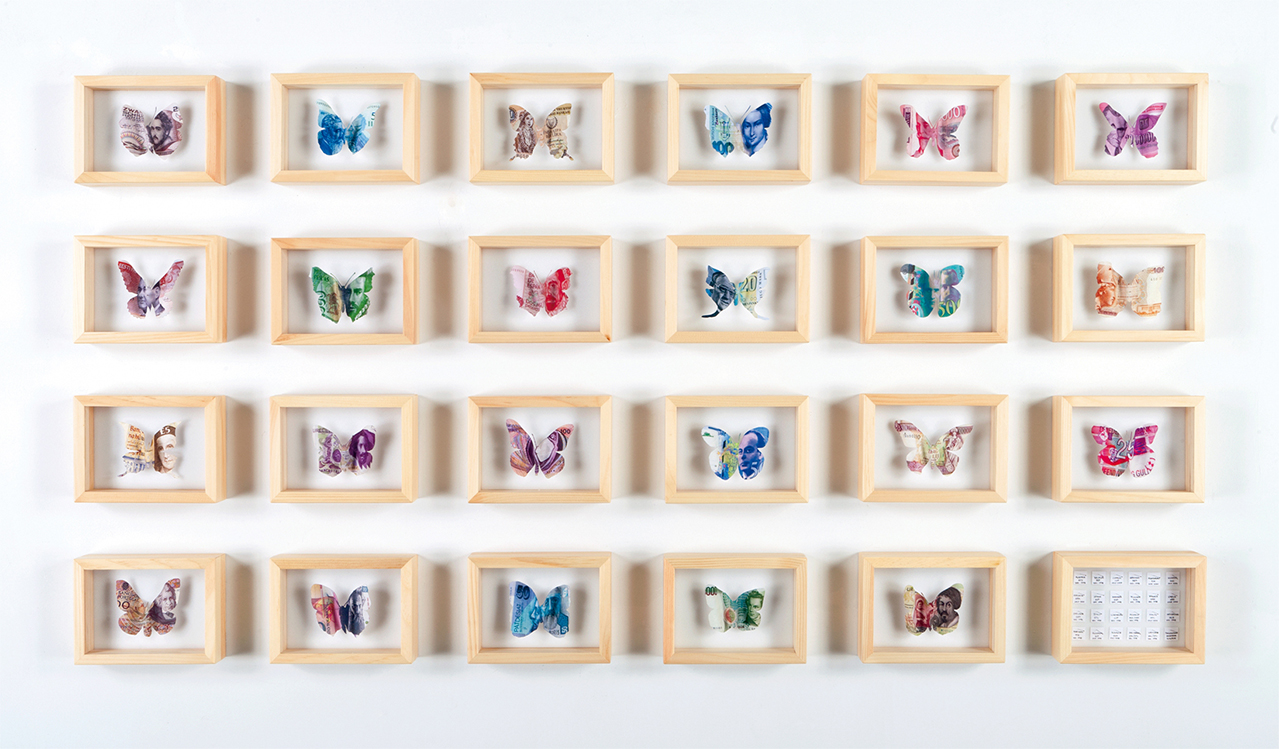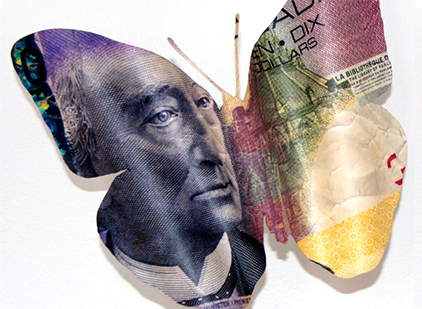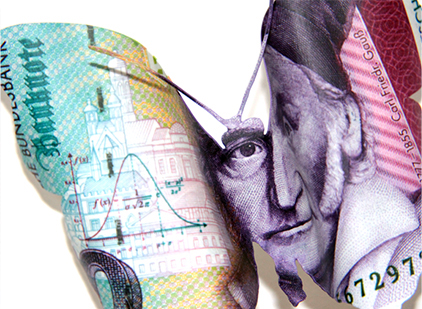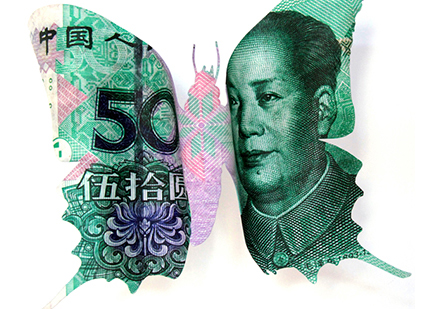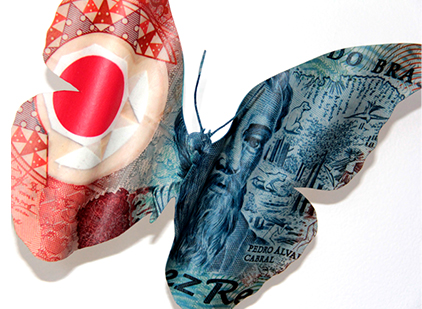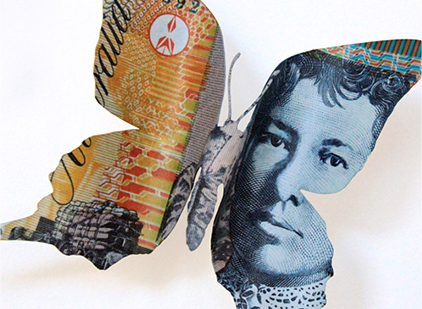
Renewable Solar Energy, 2017
Framed with museum quality acrylic box 30 w x 28 h x 6 3/4 d in10 Specimen Papilionumismia wall installation based on the top ten countries investing in Solar Energy. Germany, China, Japan, Italy, USA, France, Spain, UK, Australia, India. One of a kind framed installation with ten butterflies, three dimensional hand painted and cutout butterfly prints on archival cotton paper, UV varnished and mounted on acrylic rods. Butterflies dimensions variable.

Foreign Aid, 2017
Framed with museum quality acrylic box 30 w x 28 h x 6 3/4 d in11 Specimen Papilionumismia wall installation based on the most generous countries for Foreign Aid in percentage of Gross National Income. Sweden, UAE, Norway, Luxembourg, Denmark, Netherlands, UK, Finland,Turkey, Switzerland, Germany. One of a kind framed installation with eleven butterflies, three-dimensional hand painted and cutout butterfly prints on archival cotton paper, UV varnished and mounted on acrylic rods. Butterflies dimensions variable.

Foreign Development Assistance, 2017
Framed with museum quality acrylic box 30 w x 28 h x 6 3/4 d in10 Specimen Papilionumismia wall installation based on the most generous countries for Foreign Aid in Development Assistance. USA, Germany, UK, France, Japan, Sweden, Netherlands, Norway, Canada, UAE. One of a kind framed installation with ten butterflies, three dimensional hand painted and cutout butterfly prints on archival cotton paper, UV varnished and mounted on acrylic rods. Butterflies dimensions variable.
Humanitarian Aid Index wall installation is created upon the commitment to development and help of wealthy countries to poor ones. The size and progression of Butterfly-Specimens is based on the amount of money countries give as a percentage of their gross national income. A visual representation on how giving and receiving countries are linked in a constant flow of distribution: Vital relationships of interdependence of cash flow and resources. For that reason, I also base my installation designs on real wind vectors, evoking the motion of air masses around the globe. The circular patterns, waves and perspective lines of the designs represent the release of energy from a hidden source and its distribution through dynamic connective patterns—a constant flow that continues through the whole life cycle.
Top 20-2050 Specimen Papilionumismia collection based on a 2012 Goldman Sachs’ projection for GDP levels by nation in the future, in 2050. China, USA, India, Brasil, Japan, Denmark, Germany, UK, France, México, Italy, Canada, Turkey, Spain, Russia, Indonesia, South Korea, Phillippines, Australia, Argentina and Egypt. Wall installation with twenty butterflies, three dimensional hand painted and cutout butterfliy prints on archival cotton paper. Butterflies are UV varnished and mounted on acrylic rods. Each variable dimensions, Installation area approx. 180 x 200 cm / 6 x 7 ft One of a kind
“In 2009, Harrsch began making butterflies with partial images of various world currencies, altered in scale or other features to comply with each nation’s monetary regulations. The bills, cut into butterfly shapes, are sometimes presented in static arrangements such as Eurospecimens (2011), featuring 23 samples from across Europe in the pre-euro days, displayed in entomological boxes and accompanied by a list stating when each national currency went “extinct.” The work brings home a hard truth known to every lepidopterist (and perhaps every economist): that one often kills these beautiful creatures in order to gain knowledge of their life cycle and movements. More heartening, then, are Harrsch’s artworks that simulate liveliness (animal and fiscal alike), blending the swirling flight of butterflies, and their long-distance migratory routes, with the circulation of money both at home and across the globe.
Excerpt from ERIKA HARRSCH BOOK by Richard Vine / The Beauty of Flight
"Flow" is an elaborately conceived three-dimensional wall installation in which banknotes shaped as butterflies circulate in patterns that represent a vital connective system—like the one uniting Eaton Corporation with its partners and customers worldwide. Specimen-prints of partial images of currency from more than seventy countries, mimic the delicate beauty of butterflies in migratory flight; reflecting the transformative power of global mobility. It is a beautiful visual metaphor for the logistical and economic mission of Eaton. Each butterfly-specimen that is included, represents all the countries where Eaton has employees, their size and number being proportional to the number of people employed. In form and content, Erika Harrsch addresses direct references to cross-cultural values and diversity. Each butterfly stands out for its own individual features, hand-cut, painted and hand-shaped butterfly is native to the country where the banknote comes from. The butterfly silhouettes enfold the colorful patterns of paper money, a recognizable transformative energy flowing around the world.
After years of observing Monarch butterflies closely, often photographing and filming them at the sanctuaries in Mexico, the artist has come to be in awe of their migratory flight. The balanced perfection of the masses of butterflies in flight is fascinating, as is the subtle interplay between light and the butterflies' shifting patterns. The Monarch butterfly, during its fall migration, navigates over long distances using a time-compensated sun compass. Apparent fragility turns into energy and strength, as the winged creatures travel three thousand kilometers on their annual route, often taking advantage of wind currents to enable them to glide much of the way. For that reason, Harrsch based her installation design on real wind vectors, evoking the motion of air masses around the globe. The circular patterns, waves and perspective lines of the designs represent the release of energy from a hidden source and its distribution through dynamic connective patterns—a constant flow that continues throughout the whole life cycle.
Path Wall installation, 2013
"Reality and value as mutually independent categories through which our conceptions become images of the world", Georg Simmel
Cash Cube alludes to volatile currency markets, capital circulation and migration. The relationship between art and the ludic aspect derived from free-play, the interplay associated with games of chance and the desire to possess. My interest in games of chance began after observing the impact of the game and the fortune factor in my interactive installation, United States of North America, where the artwork became the play and game. Audience participants were invited to spin a prize wheel for the chance to win a fictitious passport. The reaction of each individual and how the game reflected on their own personal experience gave the piece a whole new dimension.
“Play is a mode of being of the work of art itself”, Hans-Georg Gadamer
Games and play have been masterfully analyzed in Johan Huizinga’s Homo Ludens and in Roger Caillois’ Man, Play and Games. Caillois sees many of the structures in society as elaborate forms of games and many behaviors as forms of play. I intend to create a parallel reality where banknotes flutter, specimen-prints of international currency as Lepidoptera, circulating inside the glass cube with an air blower. The fragile beauty, like flying butterflies in a conservatory, becomes the desired object. Who plays inside is part of the game and the game itself, immersed for a limited time and being watched. The player is seduced by the possibility of accumulation and catching the winning specimen-banknote. The subject becomes an object of contemplation from which we derive pleasure, essential features of aesthetic enjoyment.





